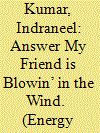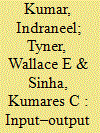| Srl | Item |
| 1 |
ID:
181806


|
|
|
|
|
| Summary/Abstract |
Two financial incentives that have spurred the growth of renewable energy including wind farms are Production Tax Credits (PTC) and Property Tax Abatement (PTA). PTC provides a tax credit of 1¢–2¢ per kilowatt-hour for the first 10 years of electricity generation for utility-scale wind, and PTA is a rebate provided by the local governments to wind farms in the U.S. Midwestern states. Past researches suggest that the breaking-even of renewable energy projects can partly be attributed to PTC. However, in cognizance of the irregular availability of such incentives, there seems to exist a need for financial feasibility analysis of the wind farms. The study uses a stochastic method and a scenario approach to address this research question. The analysis considers the capital and operating costs, interest payments, local and federal taxes, and production of wind energy and sales revenues, and inherent uncertainties in key parameters. The results shed some light on the impacts of PTC and PTA on the financial feasibility of wind farms in the U.S. Midwestern states. It is observed that PTC is a more effective instrument compared to PTA. The paper concludes by discussing policy implications of local government rebates and federal incentives.
|
|
|
|
|
|
|
|
|
|
|
|
|
|
|
|
| 2 |
ID:
150786


|
|
|
|
|
| Summary/Abstract |
Wind energy is an emerging source for renewable energy. This article presents an application of the economic input–output life cycle assessment (EIO-LCA) to estimate the greenhouse gas (GHG) emissions through the life cycle of wind energy farms in a state. The EIO-LCA incorporates manufacturing, installation, operation and maintenance, and decommissioning of the wind turbine over its life cycle period. In doing so, the study demonstrates that O&M and decommissioning of infrastructure with a longer life period can be considered to assess the total environmental impacts. The life cycle costs of wind turbine installation in Indiana is used in this study. The uncertainty in wind energy production, and hence the variability in GHG emission intensities in metric tons per gigawatt hour (GWh), is demonstrated by using the Monte Carlo simulation. The research finds that wind energy production is not entirely GHG emission-free if all the costs and life cycle stages are considered. Emission estimates have uncertainty, and O&M and decommissioning can add up to 200 metric tons of GHG emissions in CO2e per wind turbine life cycle. The regional EIO-LCA can be a helpful tool to determine strategies for state compliance to initiatives, such as the Clean Power Plan.
|
|
|
|
|
|
|
|
|
|
|
|
|
|
|
|